August 7, 2020
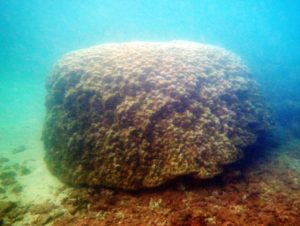
Octopus Rock, it’s popular cave bottom right. ©Susan Scott
On one of my favorite snorkeling routes, I visit a VW Beetle-sized coral head, a massive structure built over decades by millions of tiny coral bodies. The coral animals have shaped their mound a bit off the ocean floor on one side, creating a perfect place to hide.
I call this coral head Octopus Rock, because I once saw an octopus perched atop it, standing tall and alert, like a queen on her throne. We watched one another for two seconds, and then, as I raised my camera, the creature slipped down the side and disappeared beneath.
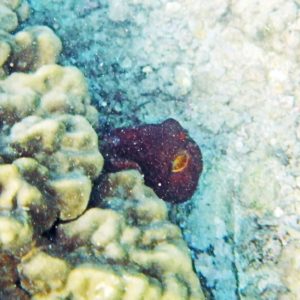
The Queen of Octopus Rock climbing down the side to her sanctuary below. ©Susan Scott
During other swims to this living mound, I’ve found a spiny lobster, several banded coral shrimp (also called barber pole shrimp), a snoozing turtle and multiple kinds of fish.
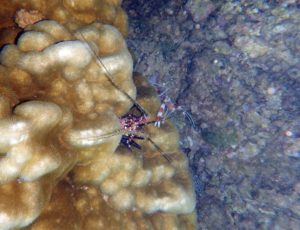
A banded coral shrimp emerged from Octopus Rock’s cave to see if this spiny lobster needed a cleaning. Coral shrimp remove parasites and dead tissue from marine animals, getting a free meal for their service.©Susan Scott
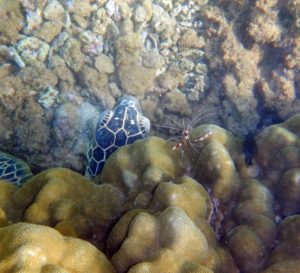
Another potential customer for the coral shrimp. This turtle sometimes sleeps under Octopus Rock.©Susan Scott
Then last month, I found something else: the empty shell of a leopard cone snail. How, I wondered, did this hefty snail shell suddenly appear on the surface rubble, as if dropped there?
The leopard snail is Hawaii’s largest cone, growing to about 9 inches long. The animal lives half buried in sand from water a few feet to 40-feet deep. Leopard cones often have algae, encrusting marine organisms, and sand stuck to their shells, making them easy to miss. Under that growth, though, and often on the part of the shell that lies face down, are rows of brown dots that sometimes run together like dashes.
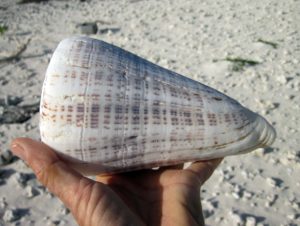
This leopard cone snails markings are clearly visible. I found this lovely shell on the beach at Spit Island, Midway Atoll. The shell remains there.©Susan Scott
If you’re checking this leopard for its spots, though, do not pick it up from the narrow end. Best not to pick it, or any cone snail, up at all. Either admire them where they lay, or roll the shell over with a tool from the shell’s wide end. I swim with a little folding knife for cutting the miles of fishing lines I often find, and use that for admiring cone snails. When done, I roll the animal back to its original place and position.
The reason for this caution is that cone snails are ambush predators. They aren’t all dangerous to humans, but some are, and they all sting. Best to keep some distance.
Cone snails hide in the sand, and depending on species, sting worms, snails, crustaceans, and fish as they hover above. The snail’s weapon is inside a hoselike “nose” that pokes out from the shell’s narrow end. This flexible tube can curve around and reach the length of the shell. When it smells food, the snail shoots its venomous stinger out from the tube, which then expands and swallows the paralyzed prey.
The animal inside my leopard cone shell was long dead, a fact I knew because the shell’s opening was face up and filled with sand, a situation no live snail, or hermit crab, would tolerate.
Back home, I discovered that something had died inside the cone shell because it stank to high heaven. After I washed it and soaked it in a bleach solution, two appendages fell out. I thought they might be a species of fireworm, but marine worm expert, Dr. Julie Brock, thought the pieces were arms of a brittle star, a type of flexible starfish. Apparently, the other 3 arms had already fallen off the dead star’s central disk, and drifted away.
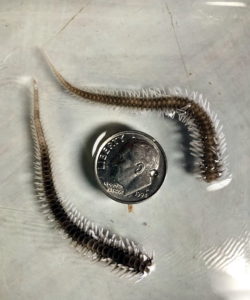
Two of a brittle star’s 5 arms, found inside the leopard cone shell. The central disk of the animal is about the size of the dime.©Susan Scott
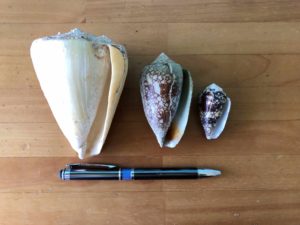
Left is the leopard cone shell I found at Octopus Rock. It smells better after two weeks of soaking and sunshine. Center and right are textile cone shells I found empty in the surrounding area.Textile cone snails are Hawaii’s most dangerous to humans.©Susan Scott
The dead brittle star didn’t solve the mystery of how a heavy leopard cone shell appeared one day under that coral head, because brittle stars can’t drag shells around like hermit crabs. Octopuses, however, can.
I like to think the octo-queen lives in that cave, reigning over her kingdom’s diverse inhabitants. But since octopuses live only a year or two, and I took the picture in 2018, that’s probably not the case. Regardless, to me that coral head will always be Octopus Rock.